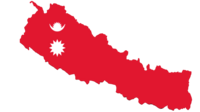
The Rai also known as Khambu and Jimee are ethnolinguistic group belonging to the Kirat family and primarily Tibeto-Burman linguistic ethnicity. They mainly reside in the eastern parts of Nepal, the Indian states of Sikkim, West Bengal and in southwestern Bhutan.

The Limbu (exonym) / Yakthung (endonym) or are a Sino-Tibetan ethnolinguistic group indigenous to the Himalayan region of eastern Nepal, Sikkim, Assam, Nagaland, northern West Bengal, and western Bhutan.

Yakkha or Dewan is an indigenous ethnic group from the Indian subcontinent, mainly in modern-day Nepal and present-day India. It is one of the descendants of Nepal's prehistoric Kirat dynasty. The Yakkha people are subsistence farmers who inhabit the lower Arun valley in eastern Nepal. They number only a few thousand and their language is nearly extinct.

The history of Sikkim begins with the indigenous Lepcha's contact with early Tibetan settlers. Historically, Sikkim was a sovereign Monarchical State in the eastern Himalayas. Later a protectorate of India followed by a merger with India and official recognition as a state of India. Lepchas were the main inhabitants as well as the Ruler of the land up to 1641. Lepchas are generally considered to be the first people, indigenous to Sikkim also includes Darjeeling.
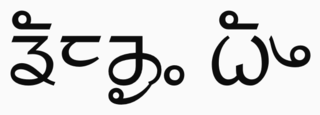
Limbu is a Sino-Tibetan language spoken by the Limbu people of Nepal and Northeastern India as well as expatriate communities in Bhutan. The Limbu refer to themselves as Yakthung and their language as Yakthungpan. Yakthungpan has four main dialects: Phedape, Chhathare, Tambarkhole and Panthare dialects.

The Kirati people, also spelled as Kirant or Kiranti, are Sino-Tibetan ethnolinguistic groups and indigenous peoples of the Himalayas, mostly the Eastern Himalaya extending eastward from Nepal to North East India.
Limbuwan is an area of the Himalayan region historically made up of 10 Limbu kingdoms, now part of eastern Nepal. Limbuwan means "abode of the Limbus" or "Land of the Limbus". Limbuwan was incorporated into the Kingdom of Nepal by means of a collective Gorkha-Limbuwan Treaty with the kings of the ten Limbuwan kingdoms and their ministers.

Budha Subba Temple is a well known religious temple of the Nepali people. It is situated in Bijayapur of Dharan, Nepal. It is believed to fulfill the wishes and bring good luck to the people visiting there. According to Kirat historian Iman Singh Chemjong, Bijaypur was the capital of the then Limbuwan Kingdom of king Bijayanarayan Raya khebang. According to others, Bijayapur was named after King Bijaya.
The Dhimal or Dhemal are Nepal ethnic group residing in the eastern Terai of Nepal. They are a Sino-Tibetan-speaking ethnic group of the eastern Terai. They mainly reside in Morang and Jhapa districts of Nepal and Darjeeling district of West Bengal, India. They are respected as the "First Citizens" of Damak municipality.
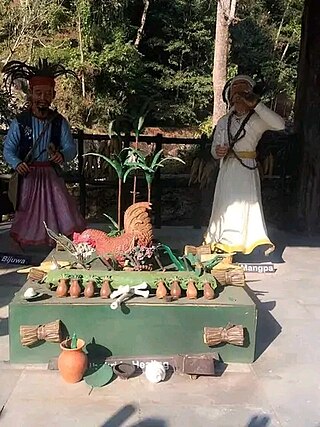
Kirat Mundum, also known as Kiratism, or Kirati Mundum, is an Indigenous religion of the Kirati ethnic groups of Nepal, Darjeeling and Sikkim, majorly practiced by Yakkha, Limbu, Sunuwar, Rai, Thami, Jirel, Hayu and Surel peoples in the north-eastern Indian subcontinent. The practice is also known as Kirat Veda, Kirat-Ko Veda or Kirat Ko Ved. According to some scholars, such as Tom Woodhatch, it is a blend of shamanism, animism, and Shaivism. It is practiced by about 3.17% of the Nepali population as of 2021.
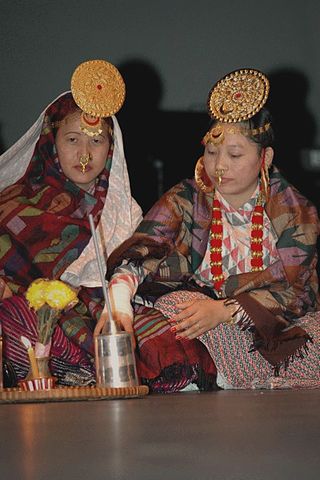
The Mundhum is the ancient religious scripture and folk literature of the Kirat people. It is an ancient, indigenous religion of Nepal. Mundhum means "the power of great strength" in the Limbu language. The Mundhum covers many aspects of the yakthung (Limbu) culture, customs and traditions that were followed since before the rise of the Vedic civilisation in the Indian subcontinent.

Sakela is one of the main festival of Khambu Rai people, an ethnic group indigenous to Eastern Nepal and Sikkim, Kalimpong, and Darjeeling regions of India. Sakela is celebrated twice a year and is distinguished by two names Ubhauli and Udhauli. Sakela Ubhauli is celebrated during Baisakh Purnima and Sakela Udhauli is celebrated during the full moon day in the month of Mangsir.
The indigenous people of Sikkim are the Lepchas and Limbus ; the naturalized ethnic populations of Bhutias, Kiratis, & Indian Gorkha of Nepalese descendants who have an enduring presence in shaping the history of modern Sikkim. The indigeneity criteria for including all peoples of Sikkim and Darjeeling hills is a misnomer as it is clearly known that Lepchas are the first people who trace their origin and culture of their ethnogenesis to the historical and somewhat political geography of Sikkim history as is well documented by colonial and immigrant settler history. However many tribes preceded the migration of the colonial powers and can trace their migratory background as well as ancestral heritage and a well formed history of civilization and cultural locus that is not inherently indigenous to Sikkim.
History of Limbuwan is characterized by the close interaction of Limbuwan with its neighbours independent and semi-independent rule characterized by autonomy for most of its time.

Tye-Angsi Sirijanga Thebe Limbu was an 18th-century Limbu scholar, educator, historian, linguist, leader, and philosopher of Limbuwan(Nepal) and Sikkim. He was formally known as Sirichongba and even more popularly known as "Sirijanga".

Indian Gorkhas, also known as Nepali Indians are an ethno-linguistic Indian groups who speak Nepali as a common language. They inhabit mainly the states of Sikkim, West Bengal, Northeast India, North Bihar and Uttarakhand, including their diaspora elsewhere in India and abroad. The modern term "Indian Gorkha" is used to differentiate the Nepali language Speaking Indians from Nepalis.
Yuma Sammang is the goddess of the Limbu community of Nepal. The deity Yuma Sammang, also known as Ningwaphuma, is widely revered and regularly worshiped among Yakthungs (Limbus). Yakthungs generally regard Yuma as a maternal figure. The Yuma Samyo or Yuma religion was very popular during the Yet Hang and Thibong Yakthung ages.
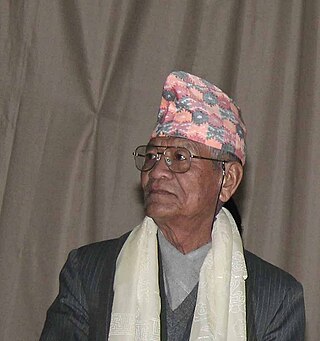
Til Bikram Nembang Limbu, professionally known as Bairagi Kainla or Bairagi Kaila, is a Nepalese poet and litterateur. He has served as Chancellor of the Nepal Academy from 2009 to 2013. Part of his significant literary struggle was the Tesro Aayam movement. During the early 1960s, he, along with Ishwor Ballav and Indra Bahadur Rai, searched unexplored realms of Nepali literature and added a new dimension – the third dimension – to Nepalese literature.

Khuwalung is a rock in the Saptakoshi river of Nepal sacred to the Kirati people. The rock lies at the confluence of Dudh Koshi, Arun, and Tamor rivers, near the Belaka municipality of Udayapur district. It is considered as one of the holiest site of the Kirati people. The name of the rock is uttered in the beginning and ending of every Kirat religious ritual.















